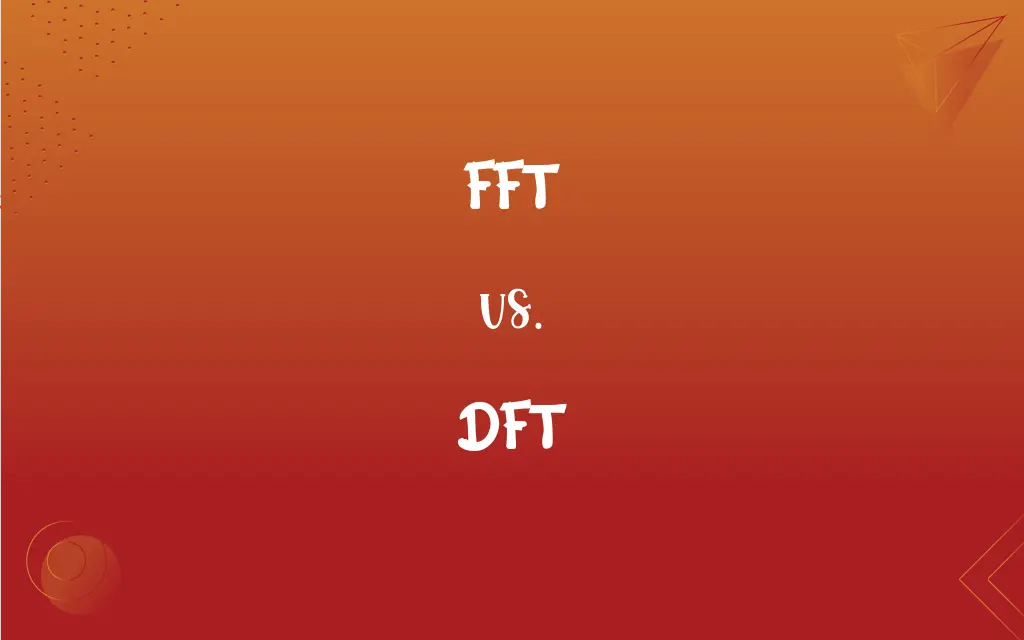FFT vs. DFT: What's the Difference?
Edited by Aimie Carlson || By Harlon Moss || Published on February 20, 2024
FFT (Fast Fourier Transform) is an algorithm to compute the DFT (Discrete Fourier Transform) efficiently, reducing computational complexity.

Key Differences
FFT, or Fast Fourier Transform, is an algorithm that efficiently computes the Discrete Fourier Transform (DFT) and its inverse. DFT, on the other hand, is a mathematical technique used to transform a sequence of complex numbers into another.
FFT significantly reduces the computational complexity of performing a DFT, making it faster for practical use. DFT's computation without the FFT algorithm involves a more computationally intensive process.
The FFT algorithm is widely used in digital signal processing because of its speed and efficiency. In contrast, the DFT is the fundamental operation, but its direct calculation is less efficient for large datasets.
FFT algorithms often utilize symmetries and redundancies in DFT calculations to reduce the number of required operations. The standard DFT calculation, however, does not inherently take advantage of these efficiencies.
FFT is essential for fast processing in various applications like audio signal processing, whereas DFT, while fundamental, is more theoretical and less practical for large-scale computations.
ADVERTISEMENT
Comparison Chart
Full Form
Fast Fourier Transform
Discrete Fourier Transform
Primary Function
Efficient computation of DFT
Transformation of complex number sequences
Computational Speed
Faster due to algorithmic efficiency
Slower for large datasets
Use in Signal Processing
Highly used due to speed
Less used directly due to complexity
Complexity
Reduced computational complexity
Higher computational complexity
ADVERTISEMENT
FFT and DFT Definitions
FFT
FFT is an efficient algorithm for computing the Discrete Fourier Transform.
The FFT was used to quickly analyze the frequency components of the audio signal.
DFT
DFT is a mathematical technique in signal processing.
We used DFT to analyze the discrete components of the digital signal.
FFT
FFT reduces the computational time for large data sets.
We implemented FFT to speed up our data processing task.
DFT
DFT transforms a sequence of complex numbers into another sequence.
The DFT was applied to understand the frequency domain of the signal.
FFT
FFT is used in various applications like audio and image processing.
FFT is a key technique in compressing audio files efficiently.
DFT
DFT converts time domain data to frequency domain.
Applying DFT helped us see the spectral characteristics of the waveform.
FFT
FFT is crucial in digital signal processing.
The FFT algorithm enabled real-time signal analysis in our application.
DFT
DFT is fundamental but computationally intensive.
The direct application of DFT is not practical for large datasets due to its computational demands.
FFT
FFT exploits symmetries in DFT calculations.
Using FFT, the computational load was significantly reduced due to its algorithmic efficiencies.
DFT
DFT forms the theoretical basis for FFT.
DFT provides the groundwork upon which FFT algorithms are developed.
FAQs
What does FFT stand for?
Fast Fourier Transform.
What is the meaning of DFT?
Discrete Fourier Transform.
What is the main advantage of FFT?
Its main advantage is the efficient computation of large data sets.
Can DFT be used for large datasets?
Yes, but it's computationally intensive compared to FFT.
Is the output of DFT complex?
Yes, DFT outputs a complex number sequence.
Is DFT used in practical applications?
DFT is fundamental but often replaced by FFT in practical applications due to efficiency.
How does FFT improve upon DFT?
FFT computes DFT more efficiently, reducing computation time.
Are FFT and DFT results identical?
Yes, but FFT achieves the result much faster.
What fields use FFT?
FFT is used in digital signal processing, audio and image processing, and more.
Why is FFT preferred over DFT in real-time processing?
Because of its faster computation speed.
What is a key application of DFT?
Analyzing frequency components of discrete signals.
Can FFT be applied to non-periodic signals?
Yes, though it's typically used for periodic or finite signals.
Is DFT relevant in digital signal processing?
Yes, as a foundational concept, though often implemented via FFT.
What is the complexity of FFT compared to DFT?
FFT has a significantly lower computational complexity.
How does FFT affect signal analysis?
It makes signal analysis faster and more efficient.
Does DFT work with continuous signals?
No, it is designed for discrete signals.
Can FFT be used for image processing?
Yes, FFT is widely used in image processing applications.
Does DFT require a specific data length?
DFT can be applied to any length, but efficiency varies.
Are there variations of the FFT algorithm?
Yes, there are several FFT algorithms for different applications.
Is learning DFT essential for understanding FFT?
Yes, understanding DFT is crucial for grasping FFT concepts.
About Author
Written by
Harlon MossHarlon is a seasoned quality moderator and accomplished content writer for Difference Wiki. An alumnus of the prestigious University of California, he earned his degree in Computer Science. Leveraging his academic background, Harlon brings a meticulous and informed perspective to his work, ensuring content accuracy and excellence.
Edited by
Aimie CarlsonAimie Carlson, holding a master's degree in English literature, is a fervent English language enthusiast. She lends her writing talents to Difference Wiki, a prominent website that specializes in comparisons, offering readers insightful analyses that both captivate and inform.







































































